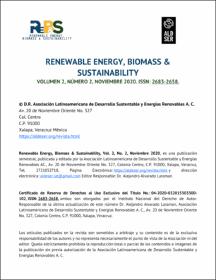Bioenergy potential from agroindustrial wastes of the state of Veracruz
Fecha
2020-11-14Autor
Nava-Pacheco, Diana
Juárez-García, Inés Adriana
Landeta-Escamilla, Ofelia
Del Moral, Sandra
Rosas-Mendoza, Erik Samuel
Metadatos
Mostrar el registro completo del ítemResumen
The use of fossil fuels is losing versus the use renewable energy sources such as biomass and biogas, due to the environmental impacts that they generate. In Mexico, Veracruz has an area of 7.24 x 106 hectares, representing 3.7% of the national area, being the main provider of agroindustrial products due to its diversity of ecosystems. The objective of this paper is to evaluate the bioenergy potential of organic solid waste generated from the main agroindustrial products of the state of Veracruz. To carry out this research, ten main crops of Veracruz were selected through a literature review, determining the percentage of waste generation and heating value of each of them. With the previous data, the tons of agroindustrial waste and the bioenergy potential were estimated. Finally, the total bioenergy potential of agroindustrial wastes was calculated. As part of the results, Veracruz produces approximately 25.5 x 106 tons of agroindustrial products made up of sugarcane, orange, lemon, pineapple, coffee, banana, grapefruit, watermelon, rice and pear. Derived from the ago-industrial activity, 6.97 x 106 tons of waste are generated annually, being the sugarcane waste the most with 75% equivalent to 5.28 x 106 tons, followed by citrus around 0.98 x 106 tons. Likewise, and as a consequence of agroindustrial waste, Veracruz has a bioenergy potential close to 130.00 PJ per year, which would place it as the largest supplier of renewable energy from biomass.
Temas
Bioenergy potentialagroindustrial waste;
biomass
biogas
heating value
Tipo
ArticleColecciones
- Artículos (DCI) [72]



